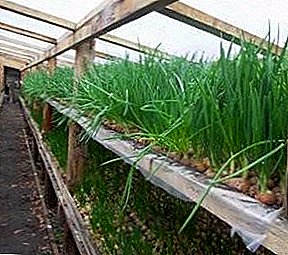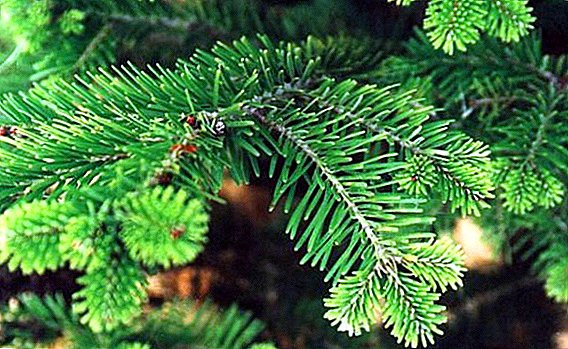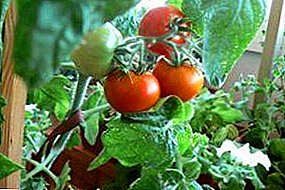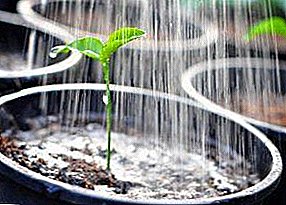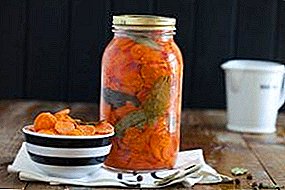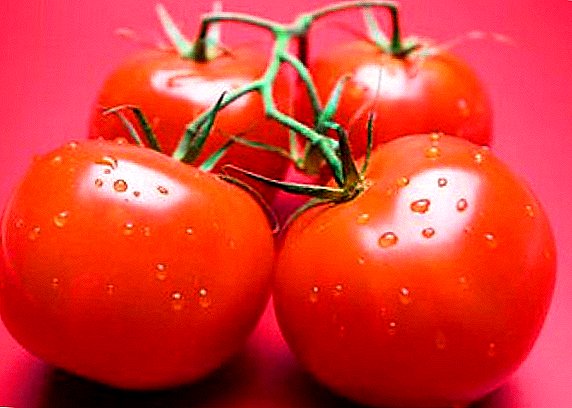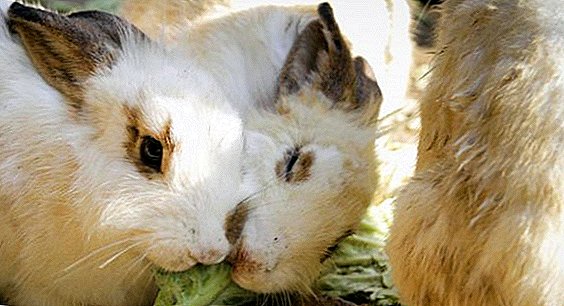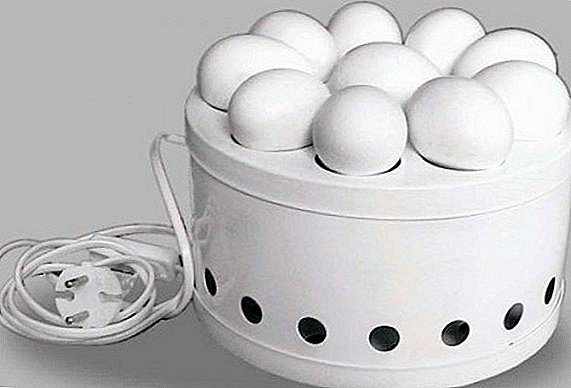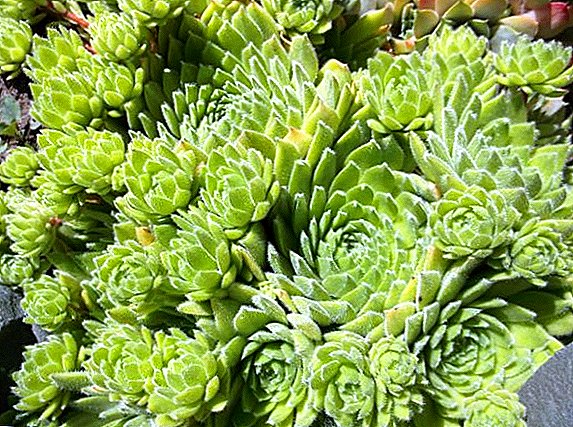 Stone rose is called a beautiful plant - young. Translated from Latin, it means "forever alive." Stone rose fell in love with the florists because of the safety of leaf rosettes throughout the season and resistance to frost. The original form of leaf rosettes and the variety of their colors give the plant a beautiful decorative look. In the world there are about 50 species of young.
Stone rose is called a beautiful plant - young. Translated from Latin, it means "forever alive." Stone rose fell in love with the florists because of the safety of leaf rosettes throughout the season and resistance to frost. The original form of leaf rosettes and the variety of their colors give the plant a beautiful decorative look. In the world there are about 50 species of young.
This article will reveal to you all the secrets of how to grow young on your site.
Did you know? In the Middle Ages, believed that the young planted on the roof protect the house from lightning strikes..
How and where is better to plant young
Rejuvenated - the plant is unpretentious, but some rules of care for him still exist. This will be discussed in the following sections.
Choosing a place
 Molodila are adapted to any climate, but it is best to plant them in a sunny place. All types and varieties of stone roses are drought tolerant. Shading for plants is contraindicated, as they are drawn out, lose their shape and bright color, and then die.
Molodila are adapted to any climate, but it is best to plant them in a sunny place. All types and varieties of stone roses are drought tolerant. Shading for plants is contraindicated, as they are drawn out, lose their shape and bright color, and then die.
Rejuvenated can also be grown in the apartment. For him, the best place would be a window sill with access to the south side.
Soil and its preparation
The stone rose has no particular preference for soil. Flowers can be grown in any soil.
The substrate should be light, sandy and not sour. The ground must also be drained. Stones and sand are placed on the bottom of the pot to remove excess moisture.
Rejuvenated can also be grown on clay-black earth soil, for this also drainage needed (a layer of gravel or small pebbles).
If you grow a plant in an apartment, then you need to use a mixture of land for cacti. You should also add to the substrate expanded clay or wood chips.
The pot is filled to one third with drainage, then ground mixture.
Technology of landing in the open ground
 Before planting reed, remove all weeds at the landing site. Since the root of the plant is not developed and does not grow deeper, the distance between young plants can be 5-20 cm.
Before planting reed, remove all weeds at the landing site. Since the root of the plant is not developed and does not grow deeper, the distance between young plants can be 5-20 cm.
It all depends on the variety. Small indentations are made in the soil. When planting, push the socket into the soil so that the plant will harden in the surface layer of the earth.
After planting, water the plant under the root. After complete drying, arrange poor watering for the plant. Flower transplanted after 4 years, as the stone rose shallows every year.
The newly planted young grows on the site in just a year, and when properly planted, rejuvenated and cared for, the sockets bloom like real roses in your garden.
How to care for young
Caring for a stone rose is quite simple. The plant is not required for irrigation, soil selection or special care. You already know how to grow young, so we are moving to caring for the plant.
Did you know? Molodil also called "hare cabbage".
Watering mode
 The plant can accumulate moisture in the leaves and use it at the right time. Additional watering is not neededexcept for a long dry period.
The plant can accumulate moisture in the leaves and use it at the right time. Additional watering is not neededexcept for a long dry period.
If the plant is watered too plentifully, the lower leaves, and then the whole plant, begin to rot.
If you grow young in your apartment, you should rarely water it. In winter, this can be done no more than 2-3 times a month, in the summer - once a week.
Important! Water should not fall into the outlet.
Loosening the soil and removing weeds
Dry inflorescences and weeds should be frequently removed around the plant. Loosening the soil will favorably affect the young.
To maintain a decorative look, areas with a stone rose are treated: weeds and faded leafy rosettes are removed.
It is necessary to loosen carefully, since the roots of the plant are located close to the surface, and there is a big risk of damaging the youth.
Feeding was young
 Since fertilizers stimulate the growth of rosettes and reduce the brightness of the color of the young, the plants do not feed.
Since fertilizers stimulate the growth of rosettes and reduce the brightness of the color of the young, the plants do not feed.
After making the feeding can be reduced frost resistance of stone roses.
Additional fertilizer is allowed only in the third year of growth. A half dose of fertilizer is used for cacti or other succulents.
How winters are young
Wintering youngsters can go without trouble in the event that you properly prepare the plant for winter.
Flowers should be protected by any improvised means that can cover the sockets, since rotting can occur from moisture ingress, which will lead to the death of the plant.
All valuable items should be covered, and this can be done, using cut plastic bottles of 5-6 l each. The lower part is cut to a height of 20 cm and turned upside down, thereby covering the rosettes of the plant.
This protection can be secured with metal pins. They will not be blown away by the wind, and the young will over-winter well under the bottle halves.
In the first winter the plants can be covered with spruce leaves, this will also save it.
Did you know? Molodil is used in folk medicine for scurry, fever and epilepsy.
Transplant was young
 A transplant can be carried out throughout the growing season. The main thing is to do it not in the late autumn, as the plants will not be able to take root before the frost, and in the spring they will be pushed out of the ground. The plants will not die, but their roots will have to be deepened.
A transplant can be carried out throughout the growing season. The main thing is to do it not in the late autumn, as the plants will not be able to take root before the frost, and in the spring they will be pushed out of the ground. The plants will not die, but their roots will have to be deepened.
A stone rose with undeveloped roots can simply be squeezed onto loose earth, and it will root itself.
When planting, only young young plants should be taken, as there is a risk that the plant will bloom, but then will not give offspring and will dry out.
Separate plants should be planted 10-15 cm apart. The distance between the stone roses depends on the size of the outlets and the length of the stems.
If there was a need to transplant overgrown roots to a different place, then it is not necessary to seat a stone rose separately. You can cut the shovel roots with a clod of earth 5-7 cm thick and transfer them to a new place.
The combination rejuvenated with other plants
Various varieties of stone roses allow you to use the plant in the formation of flower beds. Beds can be planted in the form of a carpet of the young, connecting with a stonecrop or phlox. You can also combine different types and varieties of the stone rose itself.
Important! Do not plant young near lush plants. They create a shadow, and the stone rose gets along badly next to them.
Application rejuvenated in landscape design
 The best use of stone roses in landscape design is an alpine slide. You can decorate slides with stones or plant a plant along the garden path.
The best use of stone roses in landscape design is an alpine slide. You can decorate slides with stones or plant a plant along the garden path.
Also, the plant is planted in flowerbeds and in flowerpots, combining it with various types of other flowers. The composition can be supplemented with stones.
Rejuvenated can be planted on the roofing. For example, on the roof of the gazebo, doghouse, cottage building. To protect the plant from leaching, a special garden mesh is attached to the surface of the roof.
How to increase the number of young on your site
A plant like a stone rose can and should be propagated. This can be done in 3 ways: cuttings, children and seeds. In this section, we will reveal to you the secrets of how a stone rose reproduces in these ways, and how it needs initial care.
Did you know? In the shade, the plant loses its own clear color and compactness, turning into a crumbly "cabbage".
Cuttings
 Cuttings are parts that are separated from the plant and develop into an adult plant after the formation of the roots.
Cuttings are parts that are separated from the plant and develop into an adult plant after the formation of the roots.
Propagation by grafting should be carried out during the period of growth. It is desirable that it was a warm day without rain.
To begin, cut off the healthy cuttings of the plant and sprinkle the wounds with crushed coal - this helps to avoid rotting. Before the procedure should be disinfected knife, which you will cut the outlet.
Before planting, the cuttings must be dried for 2 weeks. Wrap the lower parts of the cuttings in a newspaper and put them in an empty pot.
Then they are planted in sand or other non-nutritional mixture. Watering cuttings need warm water, but only after the formation of the root system.
To achieve optimal conditions, the plant can be covered with a transparent cap. When a complete root system is formed, the plant can be transplanted to a permanent place.
Children
Rejuvenated has side shoots that separate from the main plant, i.e. children. They have a developed root system.
This type of breeding retains maternal characteristics.
Important! Prolonged use of babies rejuvenated leads to a decrease in its quality.
 For reproduction should be separated side shoots from the parent plant. You can do it with your hands or a knife.
For reproduction should be separated side shoots from the parent plant. You can do it with your hands or a knife.
The baby is placed in the substrate to stimulate root growth. You can also spray shoots with any root growth stimulator. After this “fertilizer”, provide the necessary sunlight and a temperature of + 25 ° C for optimal development of the children.
Also, some types of stone roses form buds, from which tendrils (shoots) move to the side. In length, they can reach up to 30 cm. Shoots are planted in moist soil. This can be done in summer, autumn and spring, as the plant is unpretentious.
At a permanent place, landing is carried out in loose, prepared ground. There, the plants take root within a month, but you need to consider that the shoots can be taken differently (slowly or quickly). It all depends on the type of stone rose. Some shoots can be carried away by the wind, as the roots of the children are weak.
Seeds
Seed propagation of stone rose is a very difficult process. Seeds should be fresh, as this affects the germination of the plant. The seeds are fresher, the faster they grow. Sow best after collecting or purchasing seeds.
 Small seeds of a young age are sown in shallow pits that can be made with a pencil. The distance between the pits should be 4 cm. Small seeds of a stone rose are not sprinkled with earth, as they mix with the soil when you crush them after planting.
Small seeds of a young age are sown in shallow pits that can be made with a pencil. The distance between the pits should be 4 cm. Small seeds of a stone rose are not sprinkled with earth, as they mix with the soil when you crush them after planting.
Those seeds that you have not used, it is better to pack in paper and hide them in a plastic box. This will keep them from moisture.
After landing, the ground should be watered using a spray bottle to avoid flushing them. The term of the seedlings depends on the plant variety. The first shoots of the young appear about a week and a half. When the seedlings grow, you can transplant them to a permanent place.
Did you know? The British call young their “chickens hen”.
Pests and diseases rejuvenated, how to deal with them
The main enemy of the young are birds: magpies, jays, jackdaws and crows. They peck juicy outlets and scatter them on the site.
Also harm and blackbirds. Climbing to the roots of the young, to find the earthworms under the plant, they overturn the stone roses.
 Often young are attacked larvae of the May beetle. They gnaw through the roots and eat away the base of the shortened stem. Such rosettes need to be rooted again, removing damaged leaves and destroying the pest.
Often young are attacked larvae of the May beetle. They gnaw through the roots and eat away the base of the shortened stem. Such rosettes need to be rooted again, removing damaged leaves and destroying the pest.
The main disease of the plant is rot. Rainy weather or excessive watering leads to root decay.
The roots first become transparent, and then darken and acquire the consistency of jelly. The rot is transmitted to neighboring plants, and the diseased flowers wither.
It is necessary to closely monitor the development of plants and beginning to rot young retired on time.
If you grow a stone rose in your apartment, the plant is often damaged by aphids and worm.
Aphid loves young shoots and eats the sap of plant shoots. If the young are affected by the aphids, the shoots twist and the plant gradually withers. To get rid of aphids, you can use a chemical drug called "Inta-vir."
Redhead sucks the juice from the plant and leaves behind a sticky discharge - honeydew. Mold sticking to this dew is like soot. You can get rid of the worm with the help of "Aktelik".
Using our advice, you can easily grow a stone rose in your garden or at home.


